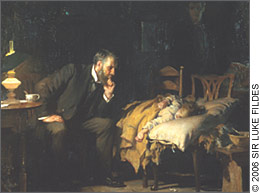
Fam Pract Manag. 2006;13(6):76
The author is a family physician in private practice in Hazel Green, Ala. Author disclosure: nothing to disclose.

The late 19th century oil painting The Doctor by Sir Luke Fildes portrays a physician keeping watch at his patient's bedside while wearing a suit and tie. The better known 1875 painting by Thomas Eakins called The Gross Clinic depicts the authoritative figure of Dr. Samuel D. Gross supervising a surgery. Dr. Gross and his colleagues look like Gilded Age robber barons in their black business suits. To the modern eye, the image of physicians wielding surgical instruments with blood-stained hands while wearing formal Victorian garb seems almost comical. The same might be said for how contemporary physicians dress.
In medical school, and to a lesser degree residency, I wore a dress shirt, tie and dark pants when seeing patients. While I have personally abandoned that practice, a great many physicians still regard a certain formality of attire as de rigueur for patient encounters.
While there is a certain dignity and decorum to dressing up for seeing patients, it seems at odds with “our sloppy, clownish, informal age.”1 Is a female patient wearing a muumuu and fuzzy slippers going to have more confidence in her physician if his trousers are sharply creased or if her skirt is perfectly pressed? Will a man wearing a baseball cap, a T-shirt with a cartoon character on it and shorts revealing scrawny, pale legs terminating in a pair of dark socks be more compliant with his doctor's instructions as a result of the perfect Windsor knot in his tie? Dressing somewhat formally once conveyed maturity, professionalism and success. Nowadays all it does is invite department store patrons to ask, “Do you work here?”
Some physicians have defected to the casual side and taken to wearing blue jeans and polo shirts at the office. This type of ensemble is often completed with a pair of tennis shoes, clogs or – perhaps as a nod to the great physicians of antiquity, Hippocrates and Galen – sandals. This garb has become popular among physicians despite a 2003 study which concluded that patients, older ones at any rate, prefer traditional rather than casual dress for their doctors.2
Adherents of the casual school of physician dress might take heart that their attire, while less professional, may be more hygienic. At a 2004 meeting of the American Society for Microbiology, it was reported that almost half of the ties worn by clinicians were found to harbor bacteria that can cause disease.3 This was eight times greater than the odds of infection in ties worn by hospital security staff. A 1991 study demonstrated that even lab coats are a potential source of infection.4 Vestments as vectors.
At my own practice all of us wear more or less identical blue scrubs every day. Scrubs are the final evolution of physician attire, the end of medico-sartorial history. They also typify the age in which we live. Unisex, featureless, strictly utilitarian, pajama-like clothes that cover the maximum area with minimum material, scrubs are the ultimate triumph of function over style. Hanging on the thin, straining on the corpulent, scrubs are democratic in their indignity to the human form. Attempts to add a note of individuality or whimsy to scrubs by adding colorful patterns or cartoon depictions only reinforce the garment's relentless banality.
Scrubs are a metaphor for modern medicine: pragmatism and expedience stripped of all vestiges of romance and mystique. They will probably reign supreme over medical apparel for the next thousand years. But I doubt they'll find their way into oil paintings that anyone will take seriously.